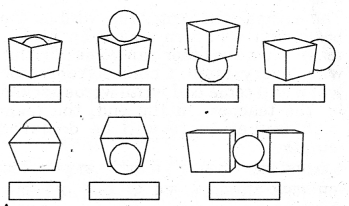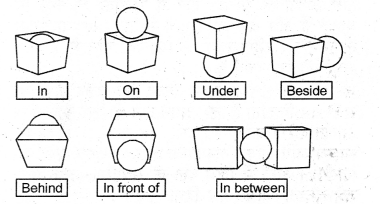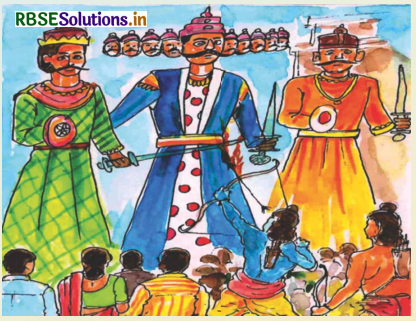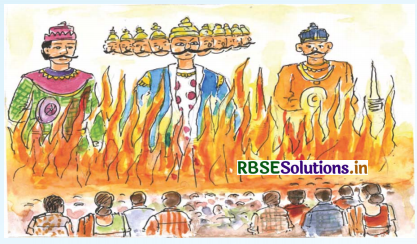RBSE Solutions for Class 5 English Chapter 6 The Dussehra Festival
Rajasthan Board RBSE Solutions for Class 5 English Let's Learn English Chapter 6 The Dussehra Festival Textbook Exercise Questions and Answers.
RBSE Class 5 English Solutions Chapter 6 The Dussehra Festival
Activity -I.
A. Choose the correct alternative सही विकल्प चुनिए
Question 1.
Which festival is also called Vijayadashmi ?
कौन-सा त्योहार विजयदशमी भी कहा जाता है
(a) Deepawali
(b) Holi
(c) Dussehra
(d) Rakhi
Answer:
(c) Dussehra

Question 2.
Dussehra is the festival of
दशहरा ........... का त्योहार है।
(a) victory of good
(b) victory of evil
(c) victory of immoral
(d) victory of rakshsas
Answer:
(a) victory of good
(B) Write 'Yes' in brackets if you agree or 'No' if you don't agree with the following statements.
यदि आप निम्नलिखित कथनों से सहमत हैं, तब कोष्ठक में 'Yes' लिखिए अथवा यदि सहमत नहीं हैं, तब कोष्ठक में 'No' लिखिए।
1. Dussehra comes in Krishna Paksha.
2. Ramleela describes the story of Ram.
3. Dussehra is celebrated on Ashwin Shukla Dashmi.
4. We should follow 'good' and give up 'evil'.
5. Hanuman's get-up attracts children.
Answer:
1. No,
2. Yes,
3. Yes,
4. Yes,
5. Yes.

(C) Answer the following questions.
निम्नलिखित प्रश्नों के उत्तर दीजिए।
Question 1.
Why do we celebrate Dussehra ?
हम दशहरा क्यों मनाते हैं?
Answer:We celebrate Dussehra as a symbol of the victory of good over evil.
हम दशहरा को बुराई पर अच्छाई की विजय के प्रतीक के रूप में मनाते हैं।
Question 2.
What is Ramleela ? Which scenes are enacted on the stage ?
रामलीला क्या है? कौन-कौन से दृश्य मंच पर अभिनीत किये जाते हैं ?
Answer:
Ramleela describes the story of Ram in the form of a drama. Every day many scenes of Ram's life as Narad Moh, Ram Janm, Ram Vivah, Vanvas, etc. are enacted on the stage.
रामलीला, राम की कहानी को एक नाटक के रूप में वर्णित करती है। प्रत्येक दिन राम के जीवन की कई घटनाएँ जैसे कि नारद मोह, राम जन्म, राम विवाह, वनवास, आदि को मंच पर अभिनीत किया जाता है।
Question 3.
How do children enjoy on Dussehra ?
बच्चे दशहरा का आनन्द किस प्रकार उठाते हैं?
Answer:
Children enjoy on Dussehra in many ways. They play the roles of various characters like Ram, Hanuman and “Rakshasas" using handmade paper arms and masks.
बच्चे अनेक तरीकों से दशहरा का आनन्द उठाते हैं। वे राम, हनुमान एवं राक्षसों समेत कई अन्य पात्रों का अभिनय कागज से बने हुए हस्त निर्मित शस्त्र तथा मुखौटे लगाकर करते हैं।
Question 4.
What was Ravan's fault?
रावण की गलती क्या थी?
Answer:
Ravan's fault was that he kidnapped Sita, and took her to Lanka.
रावण की यह गलती थी कि उसने सीता का अपहरण किया और उन्हें लंका में ले गया था।

Activity - II.
A. Choose the correct word from the 'box and fill in the blanks.
बॉक्स में से सही शब्द को चुनकर रिक्त स्थानों में भरिए।
victory, perform, masks, arrow, crackers
1. We explode .................. on Deepawali.
2. Actors come on the stage and ...... their act.
3.Children like to wear .................. of their favourite characters.
4. India got ................ over Pakistan in the Kargil War.
5. Arjun aimed his .................. at the bird's eye.
Answer:
1. crackers
2. perform
3. masks
4. victory
5. arrow
Activity - III.
(A) Look at these pictures and observe the position of the mouse and the owl.
इन चित्रों को देखिए तथा चुहे और उल्लू की स्थिति देखिए।

|
In the first image.... प्रथम चित्र में |
In the second image. दूसरे चित्र में |
These underlined words are called 'prepositions'. They are used before a noun or pronoun to show place, position, time method and other types of relationships between two nouns or pronouns.
इन रेखांकित किए गए शब्दों को prepositions कहते हैं। ये noun अथवा pronoun से पहले इस्तेमाल किए जाते हैं एवं ये स्थान, स्थिति, समय, क्रम एवं दो nouns अथवा pronouns के मध्य अन्य सम्बन्धों को दर्शाते हैं।

(B) Now look at the image below and fill suitable preposition in the given boxes.
अब नीचे दिए गए चित्र को देखिये तथा दिए गए बॉक्सों में उपयुक्त prepositions भरिए।

Answer:


Now write a sentence for each image. First one has been done for you.
अब प्रत्येक चित्र के लिए एक वाक्य लिखिए। पहला वाक्य आपके लिए लिख दिया गया है।
1. The ball is in the box.
2. ..........................
3. ..........................
4. ..........................
5. ..........................
6. ..........................
7. ..........................
Answer:
2. The ball is on the box.
3. The ball is under the box.
4. The ball is beside the box.
5. The ball is behind the box.
6. The ball is in front of the box.
7. The ball is between the boxes.
Activity - IV.
The teacher will divide the class into two groups and name those groups after great personalities like Vivekanand group, Subhash group. Now the teacher calls one student from each group and he/she will get ready with a chalk or marker in his/her hand. The teacher speaks out a word from the lesson. The boy/girl who writes the word on the board first, will earn a point for his/her team. Then the other pair comes. In this way, every team member from each team, will come and write words spoken by the teacher. In the end, the team with higher score will be declared winner.
अध्यापक कक्षा को दो दलों में बाटेंगे तथा इन दलों का नाम महान हस्तियों के नाम पर रखेंगे जैसे किविवेकानन्द दल, सुभाष दल, आदि। अब अध्यापक प्रत्येक दल में से एक विद्यार्थी को बुलाते हैं और वह अपने हाथ में चॉक अथवा मार्कर लेकर तैयार रहेगा/रहेगी। अध्यापक पाठ में से कोई शब्द पढ़कर सुनाते हैं। जो लड़का/लड़की उक्त शब्द को ब्लैकबोर्ड पर सर्वप्रथम लिखता है, वह अपने दल के लिए एक अंक अर्जित करेगा/करेगी है। इसी तरह, हर दल का प्रत्येक सदस्य आगे आकर अध्यापक द्वारा बोले गए शब्दों को लिखेगा। अन्त में जिस दल के सर्वाधिक अंक होंगे, उसे विजेता घोषित कर दिया जाएगा।
Answer:
Do yourself. स्वयं करें।

Activity V.
Write a note on how you celebrated Dussehra last time. In your description, you may write about your visit to the Ramleela ground where you saw the burning of effigies of Ravan, Meghnad and Kumbhkaran, visit to the fair, etc.
एक टिप्पणी लिखकर बताइए कि पिछली बार आपने दशहरा कैसे मनाया। अपने वर्णन में आप रामलीला मैदान की अपनी सैर का उल्लेख कर सकते हैं जहाँ आपने रावण, मेघनाद तथा कुम्भकरण के पुतलों को जलते देखा, मेले का भ्रमण, आदि।
Answer:
Last Dussehra, I enjoyed the Dussehra festival along with my parents. We went to attend the Ramlila, which is organised every year, in my city. The Ramlila ground was brightened attractively with coloured lights. Huge effigies of Ravan, Meghnad and Kumbhkaran were erected on the ground. Shortly characters of Ram and Lakshman appeared, sitting in a chariot.
People who were present there were filled with joy as Ram aimed at the effigies of Ravan, Meghnad and Kumbhakaran and blew them off with his arrows. After that, my parents took me to different food stalls where we ate panipuri, dosa and ice cream. The fair was quite attractive. Late at night, we returned home in a happy mood, taking back the memories of this auspicious festival.
मैंने पिछली बार दशहरा का त्योहार अपने माता-पिता के साथ मनाया था। हम सब रामलीला देखने गये जिसका आयोजन प्रत्येक वर्ष मेरे शहर में किया जाता है। रामलीला मैदान में रंगीन बल्बों से मनमोहक सजावट की गई थी। मैदान में रावण, मेघनाद तथा कुम्भकरण के विशाल पुतलों को खड़ा किया गया था। शीघ्र ही राम एवं लक्ष्मण के पात्र (चरित्र) रथ पर बैठकर वहाँ पर पधारे।
जनसमूह का उत्साह उस समय देखते ही बनता था, जब राम ने निशाना लगाकर राम, मेघनाद व कुम्भकर्ण के पुतलों को अपने बाणों द्वारा उड़ा दिया। तत्पश्चात्, मेरे माता-पिता मुझे विभिन्न प्रकार के खाने की दुकानों पर ले गए जहाँ हमने पानी-पूरी, डोसा एवं आइसक्रीम खाई। मेला काफी आकर्षक था। देर रात्रि, हम इस मांगलिक त्योहार की यादें संजोए अच्छे मूड में घर वापिस आए।
Q. Which festivals do you celebrate?
आप कौन-कौन से त्योहार मनाते
Answer:
We celebrate Holi, Diwali, Eid, Rakshabandhan, Christmas, and many other festivals.
हम होली, दीपावली, ईद, रक्षाबन्धन, क्रिसमस समेत बहुत से अन्य त्योहार मनाते हैं।

Q. Which festival is celebrated as victory of good over evil?
बुराई पर अच्छाई की विजय के रूप में कौन सा त्योहार मनाया जाता है?
Answer:
We celebrate Dussehra as a festival showing the victory of good over evil.
बुराई पर अच्छाई की विजय के रूप में हम दशहरा का त्योहार मनाते हैं।

Q. On which festival do we burn effigies or putlas ?
किस त्योहार पर हम पुतले जलाते हैं?
Answer:
We burn effigies or putlas on Dussehra.
हम दशहरा पर पुतले जलाते हैं।


Let's read why we celebrate Dussehra. What is the story behind it ?
आइए पढ़ें कि हम दशहरा क्यों मनाते हैं। इसके पीछे कौन-सी कहानी है?
The Dussehra Festival Summary and Translation in Hindi
In India ........... "Shukla Dashmi'. (Pages 81-82)
Word-meanings-many (मेनि) = अनेक। festivals (फेस्टिवल्ज) = त्योहार। are celebrated (आर सेलीब्रेटिड) = मनाए जाते हैं। great (ग्रेट) - बहुत। zeal (जील) = उत्साह। one of them (वन ऑव देम) = उसमें से एक। according (अका:डिग) = के अनुसार। calendar (कैलेन्डें) = पंचांग | oceurs (अकॅज़) = होता है। हिन्दी अनुवाद-भारत में, अनेक त्योहार बहुत उत्साह
के साथ मनाए जाते हैं। दशहरा उनमें से एक है। इसे 'विजयादशमी' भी कहा जाता है। हिन्दू पंचांग के अनुसार, दशहरा 'आश्विन मास' में शुक्ल दसर्वी' के दिन होता है।
On this day ........... of Ram's victory. (Page 82)
Word-meanings-Lord (लॉ:ड) = प्रभु। victory (विक्ट्रि) - विजय। kidnapped (किड्नैप्ट) = अपहरण कर लिया। fierce (फिअर्स) = भयंकर। battle (बैट्ल) = युद्ध। between (बिट्वीन) = के बीच में। ended (एन्डिड) = समाप्त हुआ। defeat (डिफ़ीट) = पराजय। army (आ:मि) = सेना। honour (ऑन्ों) = सम्मान।
हिन्दी अनुवाद-इस दिन प्रभु राम ने लंका के राजा रावण पर विजय प्राप्त की थी। वह राम की पत्नी सीता का अपहरण करके उनको लंका में ले गया। इसके फलस्वरूप राम एवं रावण के मध्य एक भयंकर युद्ध हुआ जो रावण एवं उसकी सेना की पराजय के साथ समाप्त हुआ। राम की विजय के सम्मान में दशहरा मनाया जाता है।
In many ....... the children.(Page 82)
Word-meanings-parts (पा:ट्स) = भाग। organized (ऑगनाइज्ड) = आयोजित । during (ड्यूरिंग) - के दौरान। describes (डिस्क्राइब्ज) = वर्णन करती है। form (फॉ:म) = रूप। drama (ड्रामा) = नाटक। scenes (सीन्ज़) = दृश्यों। burning (ब:निग) = दहन। enacted (एनेक्टिड) = अभिनीत। stage (स्टेज) = मंच। get-up (गेटअप) = पहनावा। attracts (अट्रैक्टस) = लुभाता है। especially (इस्पेशलि) = खास तौर पर।
हिन्दी अनुवाद-भारत के अनेक भागों में, आश्विन शुक्ल प्रतिपदा से दशमी तक, नवरात्रि के दौरान 'रामलीला' आयोजित की जाती है। रामलीला, राम की कहानी का एक नाटक के रूप में वर्णन करती है। प्रत्येक दिन राम के जीवन की कई घटनाओं, जैसे कि-नारद मोह, राम जन्म, राम विवाह, वनवास, ताड़का वध, पंचवटी का दृश्य, सीता हरण, हनुमान मिलन, लंका दहन, सेतु निर्माण एवं राम-रावण के युद्ध, को मंच पर अभिनीत किया जाता है। हनुमान का पहनावा सभी को, खासकर बच्चों को लुभाता है।

On the ............... fireworks. (Page 83)
Word-meanings-large (ला:ज) = बड़ा। effigies (एफिजीज़) = पुतले। are erected (आर इरेटिड) = बनाये जाते हैं, खड़े किए जाते हैं। stuffed (स्टफ्ट) = भरे हुए। fire crackers (फ़ाइों क्रैक:ज) = पटाखे। people (पीपल) = जनसमूह। begin (बिगिन) = आरम्भ करना। assemble (असेम्बल) = जुटना। fire-works (फ़ाइअॅवर्स) = आतिशबाजी।
हिन्दी अनुवाद-दसवें दिन, रावण, उसके पुत्र मेघनाद एवं उसके भाई कुम्भकरण के पुतले, एक विशाल मैदान पर खड़े किए जाते हैं। इन पुतलों को पटाखों से भर दिया जाता है। शाम के समय जनसमूह रावण दहन तथा आतिशबाजी को देखने हेतु जुटना आरम्भ कर देता
Fairs are ......... and masks. (Page 83)
Word-meanings-various (वेरीअस) = विभिन्न। places (प्ले सिज) = इलाके । auspicious (आस्पिशस) = मांगलिक । occasion (अकेज़न) = सुअवसर। enjoy (इन्जॉय) = आनन्द उठाना। themselves (देम्सेल्ब्ज़ ) = अपने आप को, खुद । ways (वेज़) = तौर-तरीके। roles (रोल्ज़) = किरदार। characters (कैरेक्ट:ज़) = पात्र। handmade (हैन्ड्मेड) = हस्त-निर्मित। arms (आ:म्ज़) = शस्त्र। masks (मास्क्स ) = मुखौटे।
हिन्दी अनुवाद-इस मांगलिक सुअवसर पर विभिन्न इलाकों में मेलों का आयोजन किया जाता है। बच्चे अनेक तौर-तरीकों से खुद को आनन्दित करते हैं। कागज़ के हस्तनिर्मित शस्त्रों एवं मुखौटों का इस्तेमाल करके, वे राम, हनुमान तथा राक्षसों समेत अनेक पात्रों के किरदारों का अभिनय करते हैं।
At sunset ............ over evil.(Page 83)
Word-meanings-sunset (सन्सेट) = सूर्यास्त। chariot (चेरिअट) = रथ। shoots (शूट्स) = मारता है। arrows (ऐरोज़) = तीर। catch (कैच) = पकड़ना। burn (ब:न) = जलना। ashes (ऐशिज़) = राख। explode (इक्स्प्लोड) = विस्फोटित होना। greet (ग्रीट) = अभिवादन | करना। symbol (सिम्बल) - प्रतीक। evil (ईवल) = बुरा, दुष्ट। regions (रीजन्ज़) = क्षेत्र ।

हिन्दी अनुवाद-सूर्यास्त के समय राम तथा लक्ष्मण, एक रथ में अपनी वानर सेना के साथ आते हैं। राम पुतलों पर तीर मारते हैं। पुतलों में आग लग जाती है तथा वे जलकर राख हो जाते हैं। आतिशबाजी एवं पटाखे हवा में विस्फोटित होते हैं। राजस्थान के कुछ क्षेत्रों में लोग एक-दूसरे का अभिवादन करने (मिलने) जाते हैं। दशहरा-बुराई पर अच्छाई की जीत का प्रतीक है।
